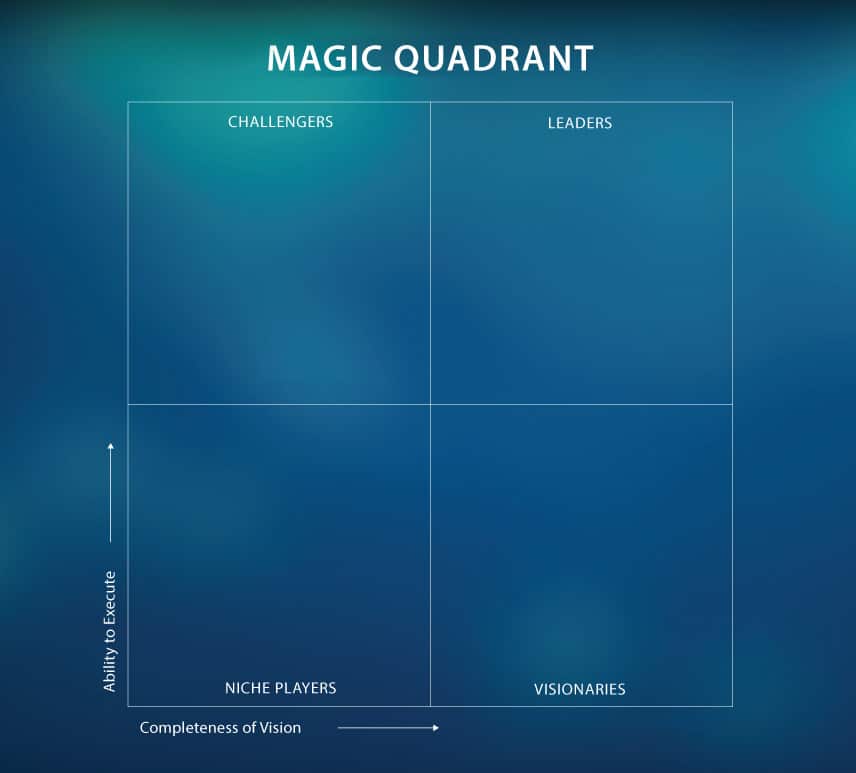Gartner's Unified Endpoint Management Leaders
Gartner's 2021 Magic Quadrant for Unified Endpoint Management Tools
 The Magic Quadrant chart, which evaluates technology providers' completeness of vision and ability to execute, puts leaders of a particular category in the top right quadrant. In this year's chart for UEM tools, most of the competitors were qualified as niche players. Only two made it to the leader quadrant: Microsoft and VMware.
The Magic Quadrant chart, which evaluates technology providers' completeness of vision and ability to execute, puts leaders of a particular category in the top right quadrant. In this year's chart for UEM tools, most of the competitors were qualified as niche players. Only two made it to the leader quadrant: Microsoft and VMware.
Microsoft
Microsoft has made incredible progress in Unified Endpoint Management, with Gartner having called its Intune for UEM an "infant" in early 2018 before it quickly brought Microsoft to the leader quadrant, where it has stayed over the past three years. In this year's assessment, there is no one close to Microsoft's ability to execute. By now what we're talking about specifically is Microsoft Endpoint Manager (MEM), which is combined with Intune and Configuration Manager and in an Enterprise Mobility + Security (EMS) license. (For more on Microsoft's often confusing licensing, see our complete comparison.) Gartner credits Microsoft for geographic diversity and its continual investment in endpoint analytics and automation. Of course, integration with Microsoft 365, Defender for Endpoint and Azure services gives Microsoft an edge in UEM through its otherwise wide presence among organizations. As Gartner notes, this "offers security capabilities that are difficult to replicate piecemeal." The flip side of this integration is that devices are only discoverable with Microsoft Defender for Endpoint (or other third-party tools) and Active Directory (AD). Gartner mentions this as a drawback to MEM, as well as the lack of some capabilities for certain IoT devices and endpoints using Chrome OS and Linux.VMware
Gartner praises VMware for the completeness of its UEM product Wordspace ONE. VMware also makes it easy for administrators, with plenty of templates, wizards, and baseline configurations. There is also a lot of flexibility for custom setups, with prebuilt connectors that allow for different kinds of integrations. Because of these design perks, VMware was rated with the best completeness of vision, slightly ahead of Microsoft on that axis. That comes at a price, though: the best features only come with the Advanced and Enterprise license tiers, which Gartner found to be some of the highest prices among all vendors. And customers who gave feedback often found it hard to justify using VMware if they were already using Microsoft 365 and Windows 10.Trends in UEM Over the Last Three Years
 It's interesting to see a visual of how the market has changed over the last three years. After sprouting from its infancy in 2018, Microsoft's UEM offering appeared solidly in the leader quadrant and climbed from there. Meanwhile, perhaps because of Microsoft's dominance, we've seen several other vendors fall from the leader quadrant, landing obversely now among the niche players. Since last year, IBM and VMware have fallen considerably, leaving Microsoft as the strongest deliverer in the field. If you're curious for more details of what brought companies like Blackberry and Citrix from leaders to niche players, you can see the full analysis of each vendor's strengths and weaknesses in
Gartner's report for this year's UEM Magic Quadrant.
It's interesting to see a visual of how the market has changed over the last three years. After sprouting from its infancy in 2018, Microsoft's UEM offering appeared solidly in the leader quadrant and climbed from there. Meanwhile, perhaps because of Microsoft's dominance, we've seen several other vendors fall from the leader quadrant, landing obversely now among the niche players. Since last year, IBM and VMware have fallen considerably, leaving Microsoft as the strongest deliverer in the field. If you're curious for more details of what brought companies like Blackberry and Citrix from leaders to niche players, you can see the full analysis of each vendor's strengths and weaknesses in
Gartner's report for this year's UEM Magic Quadrant.
Stay connected. Join the Infused Innovations email list!
Share this
You May Also Like
These Related Posts
Who's at the Top of Gartner's 2020 UEM Magic Quadrant? Intune.


Who's at the Top of Gartner's 2020 UEM Magic Quadrant? Intune.
December 7, 2020
3
min read
A Look at AI in Gartner's Hype Cycle


A Look at AI in Gartner's Hype Cycle
October 19, 2020
3
min read
The LEGO Group's Experience on Windows 365 Cloud PC


The LEGO Group's Experience on Windows 365 Cloud PC
June 23, 2022
4
min read
No Comments Yet
Let us know what you think